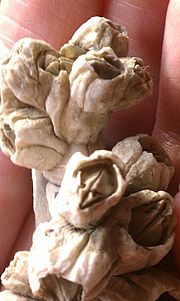Balanus glandula
From marinelife1011
Acorn Barnacle Balanus glandula
From marinelife class 2011 The Evergreen State College
| Acorn Barnacle | |
|---|---|
 |
|
| Balanus glandula. Photo taken by A. Stygar | |
| Scientific classification | |
| Kingdom: | Animalia |
| Phylum: | Arthropoda |
| Class: | Crustacea |
| Order: | Sessilia |
| Family: | Balanidae |
| Genus: | Balanus |
| Species: | B. glandula |
| Binomial name | |
| Balanus glandula Darwin, 1854 |
|
Range
Acorn Barnacle Balanus glandula is an “abundant thoracian barnacle of the Pacific high intertidal zone, ranging from the Aleutian Islands to Baja California” (1)
Lifespan
On the rock B. gladula can live for at least seven years. When B. glandula colonizes on clay their lifespan is reduced to around two years. (3)
Predators
The most common predators of B. glandula are snails: Nucella emarginata, Nucella lamellosa, Nucella canaliculata. The closer they are to the water the easier they are preyed upon by sea stars. They are capable of surviving over a wide range of tidal habitat but predation tends to keep them in a limited tidal zone where their predators are not as prevalent. (3)
Distinguishing Features
The diameter of B. glandula is usually no more than 1.5 cm, they are usually as tall as they are wide. They tend to be mostly whitish grey in color. It has a volcano like shell that is attached at the base to the substratum. The plates in the center of the barnacle come together to form a cross. There are two larger plates and two smaller plates, these plates close at the opening using muscles. They have four plates on their sides and two on top, totalling six plates. B. glandula have six pairs of cirri, which are feather like appendages. The cirri act as combs that filter the water for their food. The microscopic food is collected in the mouth parts to be consumed.(3)
Developmental Stages
Larval stage is called the nauplius, where B. glandula only has a single eye, three pairs of appendages, a pair of extensions. During this stage they are free-swimming and they have a small amount of oil to help with their floatation. After several molts they are in the cypris stage, during this stage they get the rest of their appendages and mouth pieces but the limbs are not yet turned into cirri. In this stage they can attach themselves to the substratum. B. glandula does this by ejecting a cement like glue from glands linked to the first antennae. The shell that is associated with the cypris stage is shed which completes the metamorphosis into the barnacle we normally see. During all stages of their life they rely on phytoplankton for nurishment(3.)
1. Growth, Morphology, and Laboratory Culture of Larvae
of Balanus glandula (Cirripedia: Thoracica)
Stephen K. Brown, Jonathan Roughgarden Journal of Crustacean Biology Vol. 5, No. 4 (Nov., 1985), pp. 574-590 Published by: The Crustacean Society Stable URL: http://www.jstor.org/stable/1548236
2. A Predator-Prey System in the Marine Intertidal Region.
I. Balanus glandula and Several Predatory Species of Thais
Joseph H. Connell Ecological Monographs Vol. 40, No. 1 (Winter, 1970), pp. 49-78 Published by: Ecological Society of America Stable URL: http://www.jstor.org/stable/1942441
3. Seashore Life of the Northern Pacific Coast
An Illustrated Guide to Northern
California, Oregon, Washington, and British Columbia
Eugene N. Kozloff University of Washington Press. Seattle and London. 1996.

